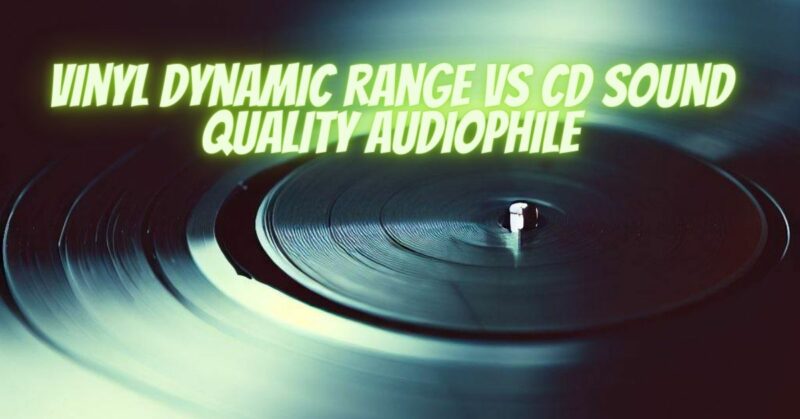For audiophiles, the pursuit of the ultimate listening experience is an ongoing journey filled with passionate debates and careful considerations. Two formats that frequently find themselves at the center of this discourse are vinyl records and CDs (Compact Discs). These formats embody different philosophies of sound reproduction, with vinyl celebrated for its analog warmth and perceived dynamic range, while CDs tout digital precision and sound clarity. In this article, we delve into the dynamic range of vinyl and CD formats from an audiophile perspective, exploring the nuances that drive the choices of discerning music enthusiasts.
Vinyl’s Analog Euphony: Dynamic Range and More
Vinyl records are revered for their analog nature, which adds a layer of warmth and character to the sound. Dynamic range, the difference between the softest and loudest sounds in a recording, is an integral part of vinyl’s appeal to audiophiles.
Pros of Vinyl Dynamic Range for Audiophiles:
- Organic Sound: Vinyl’s analog playback results in smoother transitions between quiet and loud passages, creating an organic and natural sound that mimics the live music experience.
- Emotional Connection: The wider dynamic range of vinyl can intensify the emotional impact of the music, preserving the delicate nuances of an artist’s performance.
- Ambiance and Immersion: Vinyl’s inherent imperfections, such as soft crackling and surface noise, contribute to an intimate and immersive ambiance that engages the listener on a profound level.
CDs and Digital Precision: The Audiophile’s Dilemma
While vinyl offers a unique analog charm, CDs represent a digital leap forward in sound technology. CDs provide exceptional sound clarity and accuracy, making them a preferred choice for those who value precise sound reproduction.
Pros of CD Sound Quality for Audiophiles:
- Precision and Fidelity: CDs deliver pristine audio quality with minimal distortion or noise, faithfully preserving the original recording.
- Consistency: The digital format ensures that the audio remains consistent across multiple plays and doesn’t degrade over time, guaranteeing a uniform listening experience.
- High-Frequency Accuracy: CDs can accurately reproduce high-frequency details that might be lost in analog playback, catering to audiophiles who prioritize sonic transparency.
The Audiophile’s Crossroads
The debate between vinyl and CD dynamic range encapsulates the larger audiophile dilemma—choosing between the analog warmth and imperfections of vinyl and the digital precision of CDs. Audiophiles must navigate their preferences, factoring in their equipment, listening environments, and sonic sensibilities.
Making an Informed Decision
Audiophiles should approach the dynamic range comparison with a comprehensive understanding of their preferences:
- Personal Preference: Consider whether you’re drawn to the organic character of vinyl or the precision of CD sound quality.
- Listening Setup: The quality of your turntable, cartridge, speakers, and amplification system plays a pivotal role in how dynamic range is experienced.
- Genre and Mood: Certain genres might benefit from the warm nuances of vinyl, while others might thrive with the clarity of CDs.
- Room Acoustics: The acoustic characteristics of your listening space can influence how you perceive dynamic range and overall sound quality.
The dynamic range dilemma underscores the diverse perspectives that audiophiles bring to their music consumption. While vinyl’s analog allure and wider dynamic range can evoke nostalgia and emotional connection, CDs’ digital precision and sound clarity offer a different facet of audio excellence. In the end, the choice between vinyl and CD dynamic range is a deeply personal one, informed by your appreciation for sonic aesthetics, your equipment investment, and the kind of musical experience you seek to achieve.


